The best project management software for individuals provides a centralized platform for task management, time tracking, and project planning, all within a user-friendly interface. Custom templates, workflows, and dashboards adapt to a solo user’s varying project scopes. With an intuitive mobile app, users can work on the go and manage tasks easily. A free plan is built for entry-level needs, while monthly plans start for as low as $5 per user.
- ClickUp: Best overall for remote users
- monday.com: Best for customization
- Trello: Best for small-scale projects
- Asana: Best for multiple personal projects
- Wrike: Best for scaling project managers
- Zoho Projects: Best for beginners
- Notion: Best for note-taking
- Basecamp: Best for client collaboration
One app to replace them all: Get everyone working in a single platform designed to manage any type of work with ClickUp. |

|
Best Project Management Software for Individuals at a Glance
Project Management Software | Key Features | FSB Rating | |
|---|---|---|---|
$10 |
| 4.58 out of 5 | |
$12 |
| 4.35 out of 5 | |
$6 |
| 4.24 out of 5 | |
$13.49 |
| 4.23 out of 5 | |
$9.80 |
| 4.21 out of 5 | |
$5 |
| 4.09 out of 5 | |
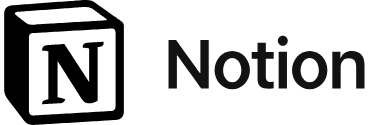 | $10 |
| 3.95 out of 5 |
$15 |
| 3.47 out of 5 | |
Quiz: Find Your Ideal Project Management App
Which project management software for individuals is right for you?
ClickUp: Best Overall for Remote Users

What We Liked
- Has generous free plan inclusions
- Has offline mode for desktop and mobile
- Has rich task management tools
Where It Falls Behind
- Has only 49 apps for native integrations
- Can be complex to navigate
- Can be overwhelming for beginners
ClickUp Monthly Pricing (per User) Take up to 30% off when you pay annually.
- Free Forever: Free for 100MB storage, task checklists, templates, spreadsheets, custom statuses, 100 automations, multiple assignees, dependencies, in-app video recording, real-time chat, integrations, and time tracking
- Unlimited: $10 for unlimited dashboards, unlimited file storage, custom fields, form view, Gantt chart, guest access, 1,000 automations, portfolios, recurring tasks, delegate reminders, and milestones
- Business: $19 for unlimited teams, custom reporting, 10,000 automations, goals folder, workload management, mind map, timelines, and public sharing
- Enterprise: Custom pricing for white labeling, 250,000 automations, team sharing, unlimited custom roles, and document tags
We pick ClickUp as the best project management app for individuals working remotely, thanks to its offline access and mobile accessibility. In cases of poor internet connection, ClickUp automatically enters Offline Mode and lets you continue creating tasks and reminders while offline. All changes will automatically sync with your Workspace after reconnecting.
ClickUp users can keep track of their projects on any device because of its impressive mobile accessibility. Besides its desktop and mobile app, ClickUp is available on Apple Watch, so you can update your status and check notifications on the go. It also integrates with Siri and Alexa, which you can use through voice commands to create reminders and tasks.
The feature-rich nature of ClickUp makes it one of the most powerful project management solutions on the market. However, this can easily overwhelm users who have basic needs and do not require team collaboration tools. If you’re looking for an entry-level alternative, check out Zoho Projects, which emphasizes simplicity and ease of use.
ClickUp Features

ClickUp’s free forever plan offers up to 60 custom field uses. (Source: ClickUp)
- Embed view: Add interactive items like websites and apps alongside your project tasks. This keeps your screen organized and uncluttered by placing items in a single place.
- Custom assignees: Assign a task to a single person or multiple team members. Turning on this feature will enable you to add more than one person to a single task.
- Custom fields: Adding custom fields to your workspace lets you add different types of data, whether on a folder, list, task, or subtask.
monday.com: Best for Customization

What We Liked
- Has a user-friendly interface
- Has up to 200 project templates
- Has customizable notifications
Where It Falls Behind
- Has an inflexible mobile app
- Has a minimum seat requirement for paid plans
- Locks the time tracking feature at the third tier
monday.com Monthly Pricing (per User) Pay annually and take up to 18% off per user. All paid plans have a minimum seat requirement.
- Free: Free for two seats, three boards, a whiteboard, 500MB storage, shareable forms, 200+ templates, kanban view, and custom notifications
- Basic: $12 for unlimited free viewers, 5GB storage, unlimited boards, and custom fields
- Standard: $14 for 20GB storage, timeline and Gantt views, guest access, and 250 actions for automation and integrations
- Pro: $24 for 100GB storage, time tracking, workload, dependency column, and 25,000 actions for automation and integrations
- Enterprise: Custom pricing for 1TB storage, advanced reporting and analytics, and 250,000 actions for automation and integrations
- Free trial: 14 days
monday.com is one of the most flexible project management apps for individuals who need a customizable platform to tackle multiple projects. Set up your boards by adding columns containing various information, including status, dates, numbers, and timers. Plus, you can personalize each cell with color labels to quickly distinguish items at a glance.
There are over 200 board templates to choose from, each customizable to suit your needs, including item names, groups, and columns. You can also create your own automation recipe based on your workflow preferences.
Despite its user-friendly nature, monday.com is not suited for users with no plans of scaling soon or adding more users in the future. Premium subscriptions have a required team size (starts at three seats per plan). Instead, check out ClickUp, which is almost as affordable as monday.com and allows single users to upgrade to a paid subscription.
monday.com Features
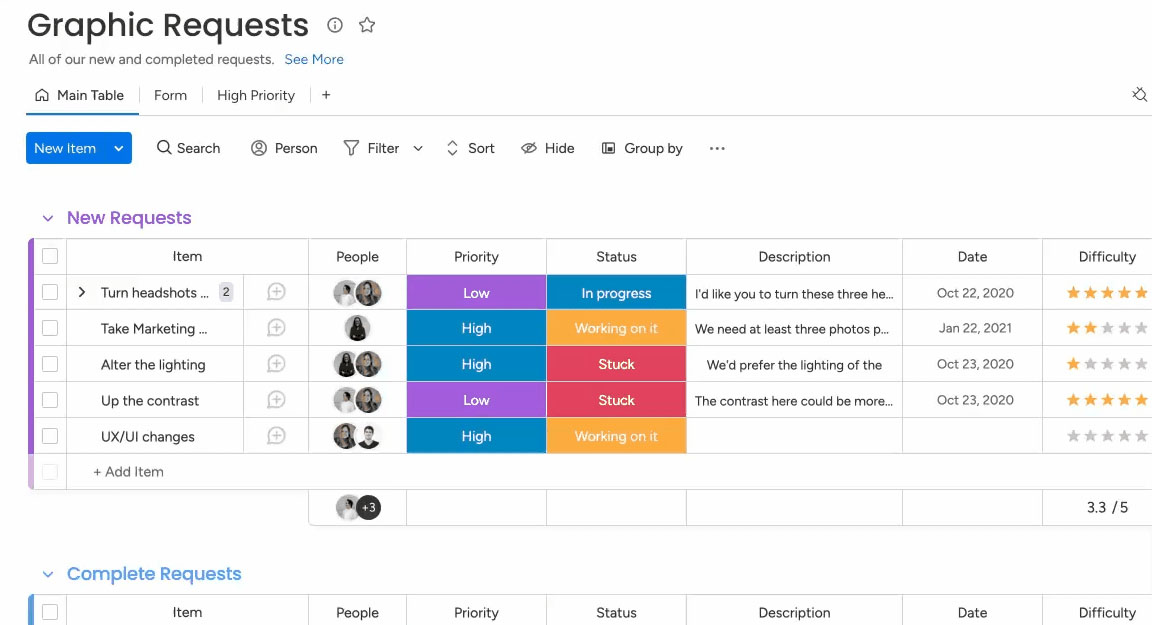
Narrow down your search by using the board filter. (Source: monday.com)
- Workload view: Easily visualize and monitor the hours that team members spend on each task. This feature also applies to equipment and resources.
- Column types: Columns are the building blocks of a monday.com board, offering a streamlined way to customize your workspace. Column types include people, date, text, and timeline.
- Board filter: Since boards are filled with tons of information, filters let you easily access the specific information you need. Filtering options include the search bar, person filter, and quick suggested filter.
Trello: Best for Small-scale Projects

What We Liked
- Is the cheapest option on the list
- Is straightforward to use
- Has a functional mobile app
Where It Falls Behind
- Requires add-ons for its core features like time-tracking
- Limits Free users to the kanban view
- Is not ideal for complex tasking
Trello Monthly Pricing (per User) Discounted annual subscription fees start at only $5 per user monthly.
- Free: Free for up to 10 boards, built-in automation, templates, unlimited storage (10MB per file), 250 workspace command runs, unlimited activity log, and app integrations
- Standard: $6 for unlimited boards, checklists, unlimited storage (250MB per file) custom fields, and 1,000 Workspace command runs
- Premium: $12.50 for dashboard views, workspace views, templates, data export, and admin and security features
- Enterprise: $17.50 for unlimited workspaces and organization-visible boards
- Free trial: 14 days (Premium only)
Trello is the best project management app for individuals working on small-scale projects. Its intuitive, highly visual kanban-style boards make it easy to track and organize tasks. While competitors boast feature-rich plans, Trello emphasizes simplicity by giving users the freedom to add features and third-party app integrations through its Power-Ups marketplace.
This provider’s core framework revolves around boards, lists, and cards, making it less complex than other tools. Set up lists to indicate different stages of a task, and simply drag items across lists as you make progress. You can also break down big tasks into smaller chunks by using advanced checklists.
Given its simplicity, Trello is not suitable for managing large projects as it can become overwhelming when filled with several items. If you’re looking for an alternative to using Trello, check out monday.com, a versatile project management software for individuals with extensive customization options to handle more complex project needs efficiently.
Trello Features
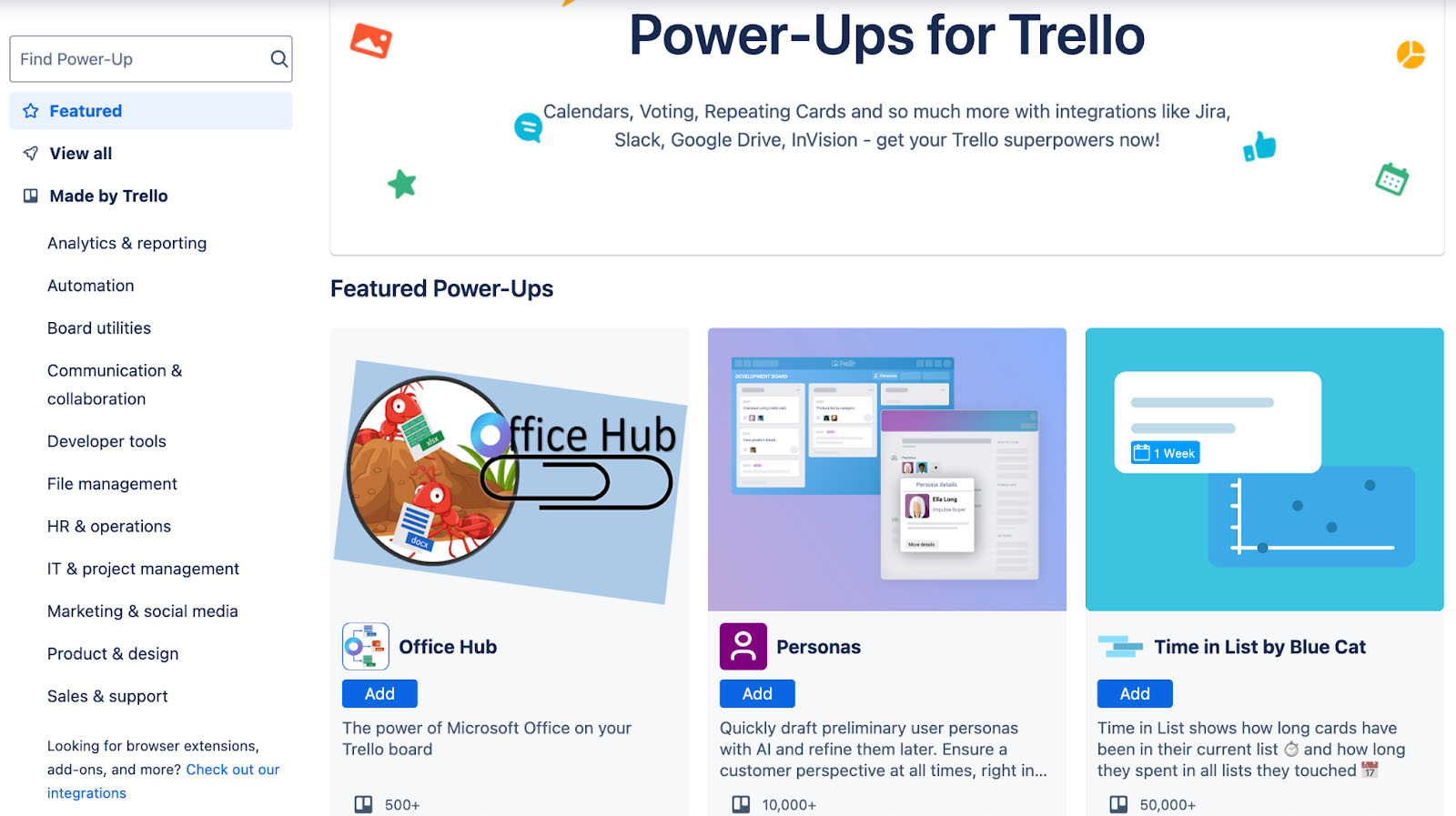
Use Power-ups to add your favorite tools to your Trello board. (Source: Trello)
- Attachments: Upload file attachments onto a card and keep all project items in one place. Simply drag and drop the file or paste the link in the link field.
- Power-Ups: Integrate extra features and apps to extend the functionality of your Trello board. Choose from up to 11 categories, such as sales, automation, and social media.
- Calendar view: Add third-party calendars like Google, Outlook, and Apple to visualize project deadlines alongside your upcoming events. Drag and drop items based on their timeline or due date.
Asana: Best for Multiple Personal Projects

What We Liked
- Has generous free plan inclusions
- Is very easy to use
- Has robust task management tools
Where It Falls Behind
- Lacks budgeting functionality
- Is not ideal for low-use scenarios because of its feature-rich nature
- Lacks offline mode for desktop users
Asana Monthly Pricing (per User) Discounted annual fees start at $10.99 per user.
- Basic: Calendar view; unlimited tasks, messages, and storage; board view projects; and 100-plus integrations
- Premium: $13.49 for forms, workflow builder, timeline, reporting, custom templates, and unlimited dashboards
- Business: $30.49 for custom rules builder, workload, portfolio, time tracking, advanced reporting, forms branching, and approvals
- Enterprise: Custom pricing for a minimum of 50 users, multi-board guests, unlimited workspaces, and advanced security and governance
- Free trial: 30 days
While Asana is built for large-scale projects and team collaboration, it also caters to individual users managing multiple tasks simultaneously. The free Personal plan allows unlimited usage for task creation, projects, messages, activity logs, and file storage, providing users with everything they need to juggle multiple projects without upgrading to premium plans.
Another key selling point of Asana is its flexibility in adapting to any task management need, whether for personal to-dos, event planning, or daily task lists. Board, list, and timeline views help streamline projects and establish a centralized workspace that houses all information related to a specific task.
Unfortunately, Asana’s feature-rich nature can be a disadvantage for users who simply need a project management planner for low-volume tasking. Check out Trello if you’re looking for a more straightforward tool built for individual use. Although both providers share many similar features (e.g., task and workflow management), Trello is easier to set up and configure.
Asana Features
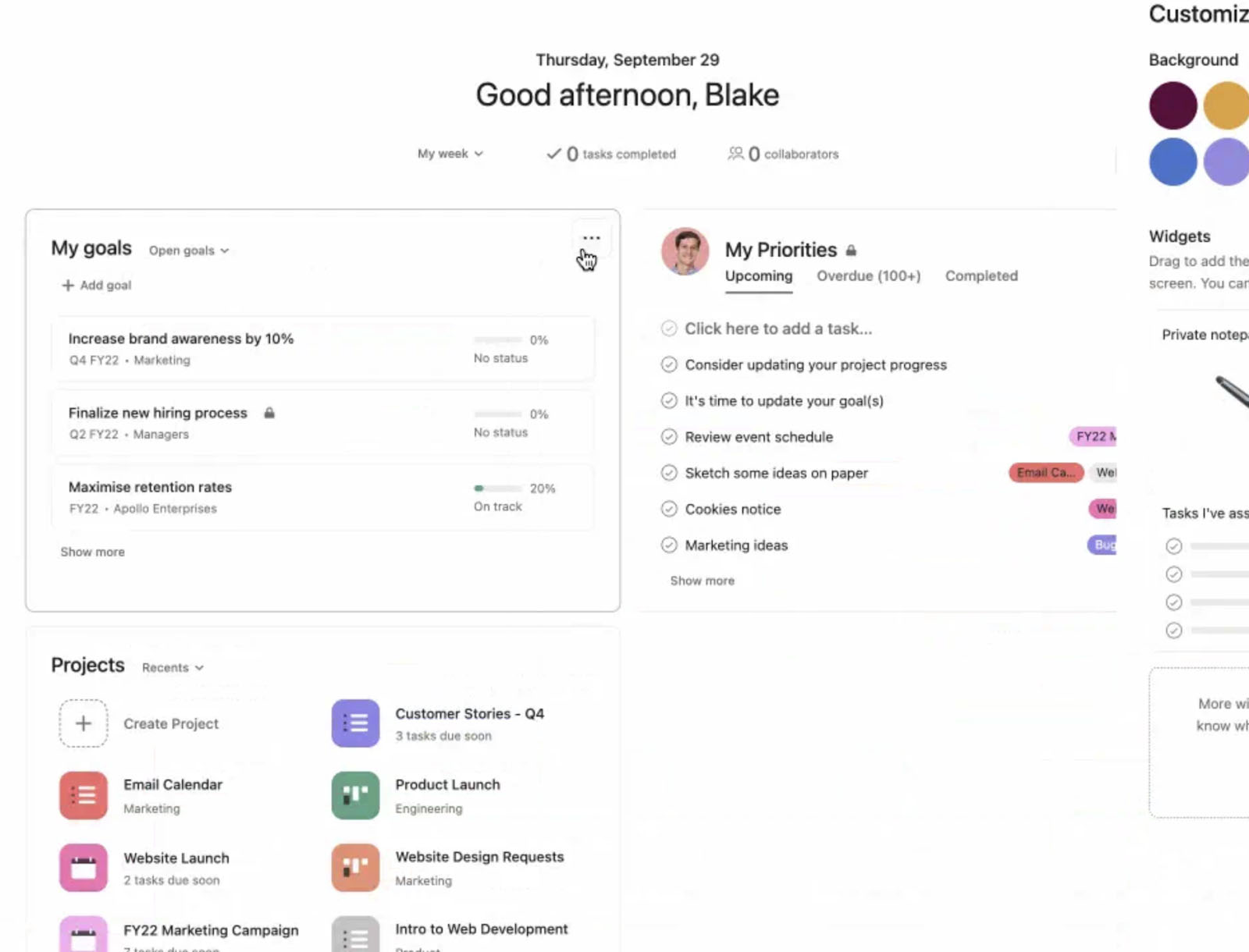
Track your project goals directly from your Asana home page. (Source: Asana)
- Status updates: Post project updates in minutes through time-saving automation. On your dashboard, drag and drop project highlights like charts, milestones, and summaries to visualize progress instantly.
- Goals: Set your company objectives and connect each of them to the portfolios and projects so everyone in your team will accomplish the right tasks assigned to them.
- Bundles: Standardize work processes by combining fields, sections, rules, and templates that you can apply across multiple projects at once.
Wrike: Best for Scaling Project Managers

What We Liked
- Has no user limits on its Free plan
- Has robust AI features
- Has extensive third-party integrations
Where It Falls Behind
- Has very limited automation credits
- Can be complex to use
- Lacks monthly billing option
Wrike Monthly Pricing (per User) All plans are billed on an annual prepayment basis.
- Free: Free for 2GB per account, task management, custom work views, work intelligence, project templates, and enterprise-grade security
- Team: $9.80 per user for up to 25 users, custom fields and workflows, calendars, dashboards, Gantt chart, work schedules, analytics view, request forms, and 50 automations
- Business: $24.80 per user for up to 200 users, 5GB storage, portfolio, live reports, custom templates, approval, time tracking, and folder hierarchy
- Enterprise: Custom pricing for unlimited users, 10GB storage, 1,000 automations, and advanced security controls
- Pinnacle: Contact sales for 15GB storage, advanced analytics, 1,500 automations, capacity planning, and locked spaces
- Free trial: 14 days
Wrike revolutionizes project management for individuals with its work intelligence solution. It suits project managers who anticipate scaling their one-person operation or expanding their team. With its enterprise-grade capabilities, it outperforms other competitors by offering powerful features, such as risk prediction, resource management, and content creation.
Generative AI speeds up project planning by constructing project briefs from scratch. It also works as a language translator, checks for grammar mistakes, and summarizes lengthy discussions. It’s like your personal AI assistant that works in the background, so you don’t have to manually update your projects and tasks.
Note that Wrike doesn’t have a monthly billing option, which can be expensive for users who don’t want to be tied to a long-term contract. If you’re looking for a cheaper alternative to Wrike, try Zoho Projects. With a monthly per-user fee of $5, Zoho Projects is one of our best project management tools for individuals on a budget.
Wrike Features
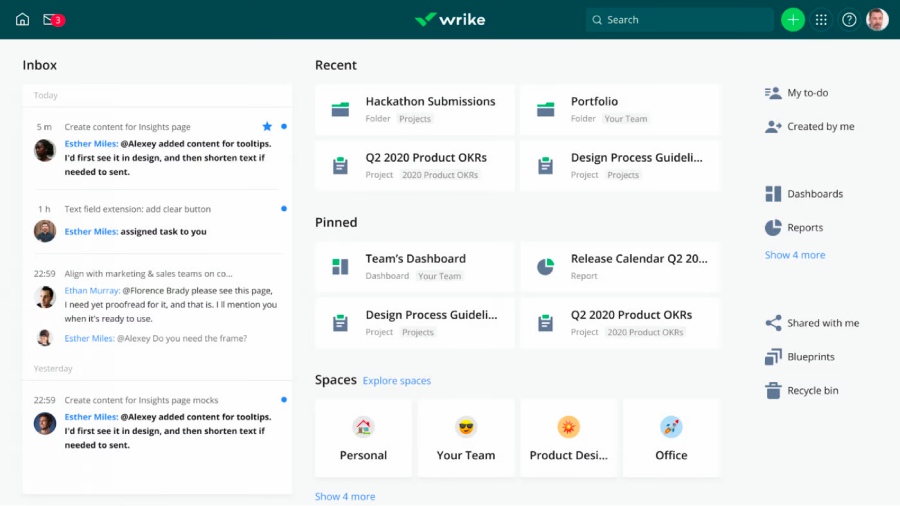
A customizable workspace where you can easily manage your work (Source: Wrike)
- Resource bookings: Estimate the number of hours you will need to work on a project without a detailed work plan. This is useful in project forecasting and anticipating portfolio resource needs.
- External requester collaboration: Communicate with non-Wrike users by setting external request forms to facilitate email communication. This enables everyone to access all assets in one place.
- Personal work experience: Provides a full-screen view of all your assigned tasks. Use filters and custom widgets to manage your tasks and organize your workspace.
Zoho Projects: Best for Beginners

What We Liked
- Has affordable per-user fees
- Has a wide range of collaboration options
- Has rich time-tracking tools
Where It Falls Behind
- Has only 30 project templates to choose from
- Has a slight initial learning curve
- Limits its Free plan to two projects
Zoho Projects Monthly Pricing (per User) Save up to 12% per user if you pay annually.
- Free: Two projects, 5GB storage, basic reporting, task management, file sharing, calendar, custom status, and productivity app integrations
- Premium: $5 for unlimited projects, 100GB storage, 20 templates, Gantt chart, subtasks, time tracking, export projects, budgeting, dependency, and reporting
- Enterprise: $10 for 120GB storage, 30 templates, flexible work hours, workflow rules, custom fields, and issue tracking
- Free trial: 10 days
Zoho Projects is one of the best project management tools for individuals wanting to quickly organize tasks in a cloud-based environment without unnecessary complexities. Its structured approach to task management lets you easily create tasks, set up reminders, and customize task views.
Customization capabilities include project views, automations, layouts, and templates. This level of personalization allows users to tailor the platform to their specific needs and makes it less overwhelming to use. If you’re a freelance IT professional, Zoho Projects also works as an issue-tracking tool, allowing you to easily track issues and bugs in your projects.
On the downside, Zoho Projects significantly falls short of its free plan as it restricts users to just two projects and 5GB storage and lacks advanced tasking features. If you’re in search of a free project management app that doesn’t skimp on features, check out Asana’s generous free personal plan.
Zoho Projects Features
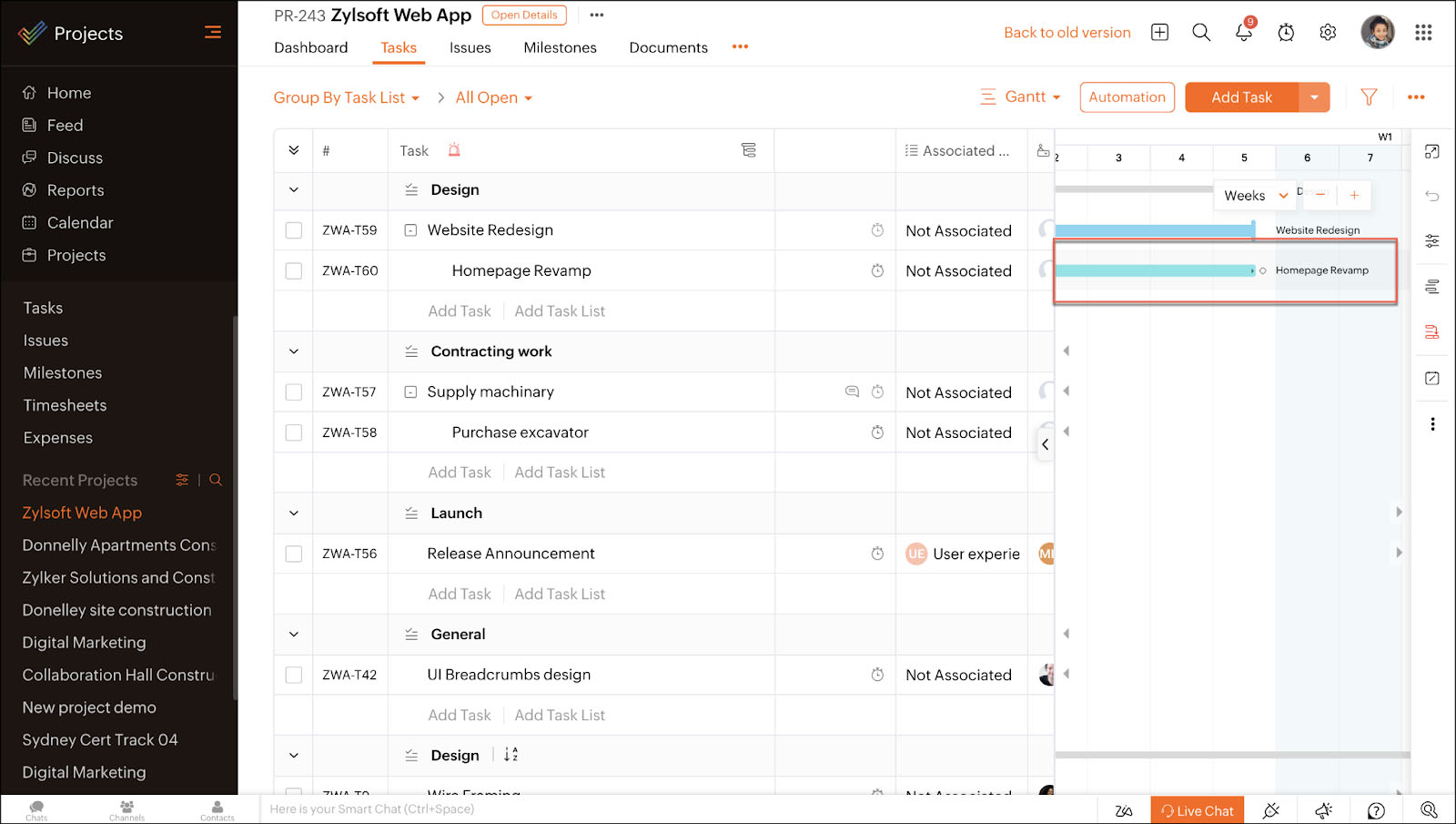
Roll up percentage completion from tasks on the Gantt chart. (Source: Zoho Projects)
- Recurrence: Eliminate the hassle of recreating tasks periodically. Set up recurring tasks to be scheduled on a daily or weekly basis and assign them to users automatically.
- Task roll-up: Summarize project data, including overall duration, planned work hours, and actual logged hours based on a project’s tasks and subtasks. This provides a full view of project progress and estimates of the total time for project completion.
- Task custom view: Filter your tasks based on specific criteria to get a quick view of the work items you want to prioritize. You can customize the view to display tasks that are overdue, high priority, or under a certain department.
Notion: Best for Note-taking

What We Liked
- Has extensive database tools
- Offers an all-in-one tool for notes, tasks, and wikis
- Has affordable premium plans
Where It Falls Behind
- Has a customization feature that can be complex and time-consuming
- Lacks features like time tracking
- Has no offline mode
Notion Monthly Pricing (per User) Save up to 20% if you opt for pre-annual billing.
- Free: Unlimited pages and blocks, basic page analytics, seven-day page history, calendar, timeline view, subtasks, dependencies, formulas, and basic automation
- Plus: $10 for unlimited file uploads, 30-day page history, public home page with custom domain, 100 guest invites, and custom database automation
- Business: $18 for bulk PDF export, advanced page analytics, 90-day page history, 250 guest invites, and private team spaces
- Enterprise: Custom pricing for unlimited page history, admin permissions, and advanced security controls
More than a project management tool, Notion works as a note-taking app for building knowledge bases and documentation. A Notion page is a fresh canvas where you can add any piece of content, including text, images, and a to-do list. You can also create subpages within a page to create centralized content, such as a knowledge base, databases, public websites, or project workflows.
With its extensive customization options, Notion offers many configurable ways to create a workspace that reflects your work style. However, this degree of flexibility forces users to spend significant time and effort building their productivity platform. If you prefer to manage your tasks more efficiently from the get-go, then Trello is a more practical and intuitive choice.
Notion Features
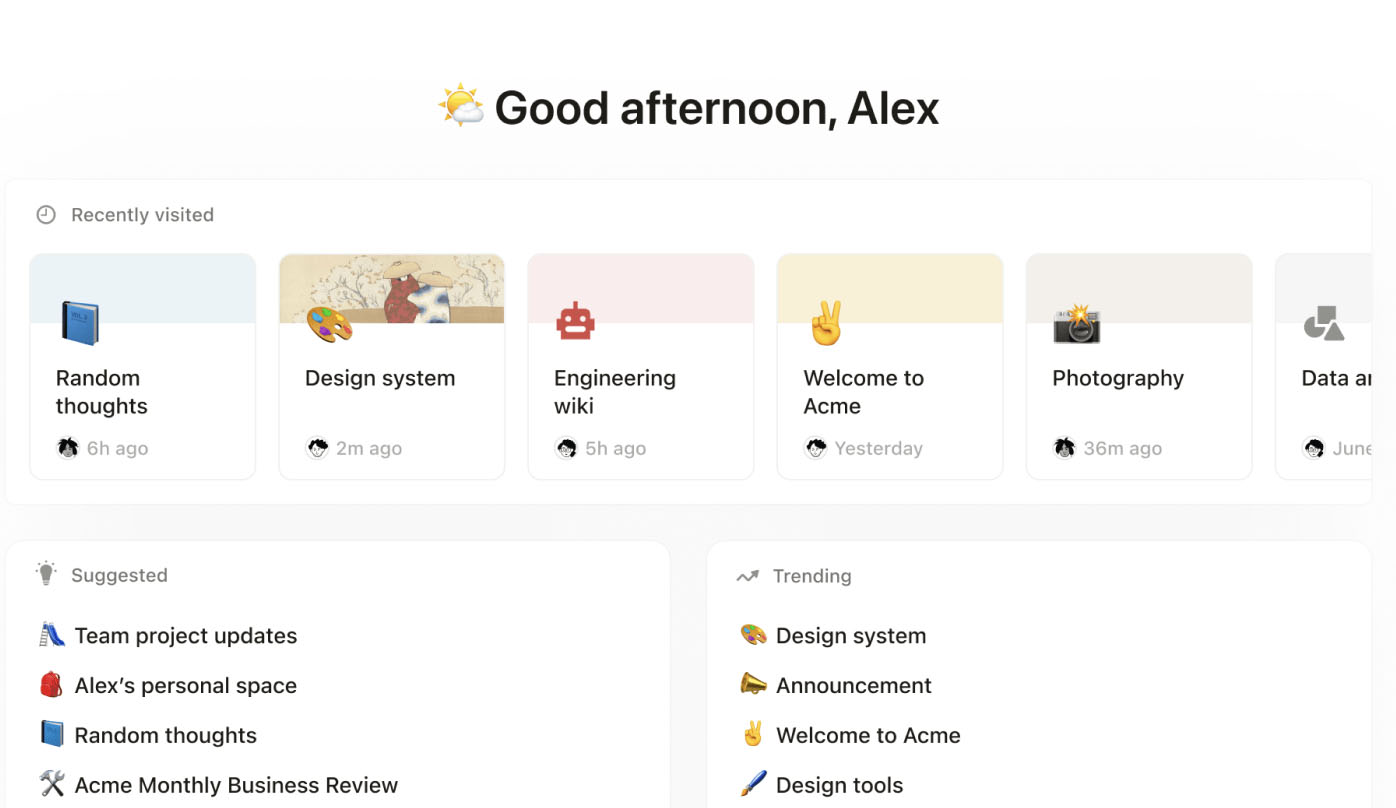
Quickly access relevant notes within your Notion home page. (Source: Notion)
- Wiki: Create a centralized database to display any work item you want. Build subpages, choose layouts, and add filtering rules.
- Notion Calendar: See all your schedules and upcoming events in one place, alongside your deadlines and project timelines. Built-in scheduling lets you send your availability to your clients so they can book time with you.
- Notion AI: Purchasing the AI add-on plan provides unlimited use of generative AI features, including Q&A, autofill, and writer. Get the answers you need within seconds using information across your projects, docs, and wikis.
Basecamp: Best for Client Collaboration

What We Liked
- Has rich collaboration features
- Provides free guest access
- Provides an option to pay a fixed monthly fee for unlimited users
Where It Falls Behind
- Has a limited customization
- Lacks free plan except for academic use
- Has a higher per-user fee compared with competitors
Basecamp Monthly Pricing
- Basecamp: $15 per user monthly for 500GB storage for files and documents
- Basecamp Pro Unlimited Pay only $299 per month for unlimited users if you pay on a pre-annual basis. : $349 for unlimited users, 5TB document storage, priority support, onboarding tour, and admin pro pack
- Free trial: 30 days
All plans include unlimited projects, group chat, project schedules, to-do lists, role assignments, automatic check-ins, card tables, timeline views, activity reports, message boards, free guest access, and integrations
Basecamp is notably known for its extensive collaboration features, but it also caters to individuals working closely with clients. Invite an unlimited number of guests without charges and centralize client feedback, approvals, requests, and project communications in one intuitive platform.
Before adding a client, Basecamp lets you configure the privacy settings so you can decide what your clients can view and access. You can also keep records of entire client conversations, send automatic updates to clients, and let clients grab the files they need without asking.
Despite the noteworthy features of Basecamp, this provider offers multiple collaboration tools that may be unnecessary for individual users. If you simply need a project management tool for basic note-taking and task management, check out Notion. This provider offers a highly customizable app for managing projects and content seamlessly in one place.
Basecamp Features
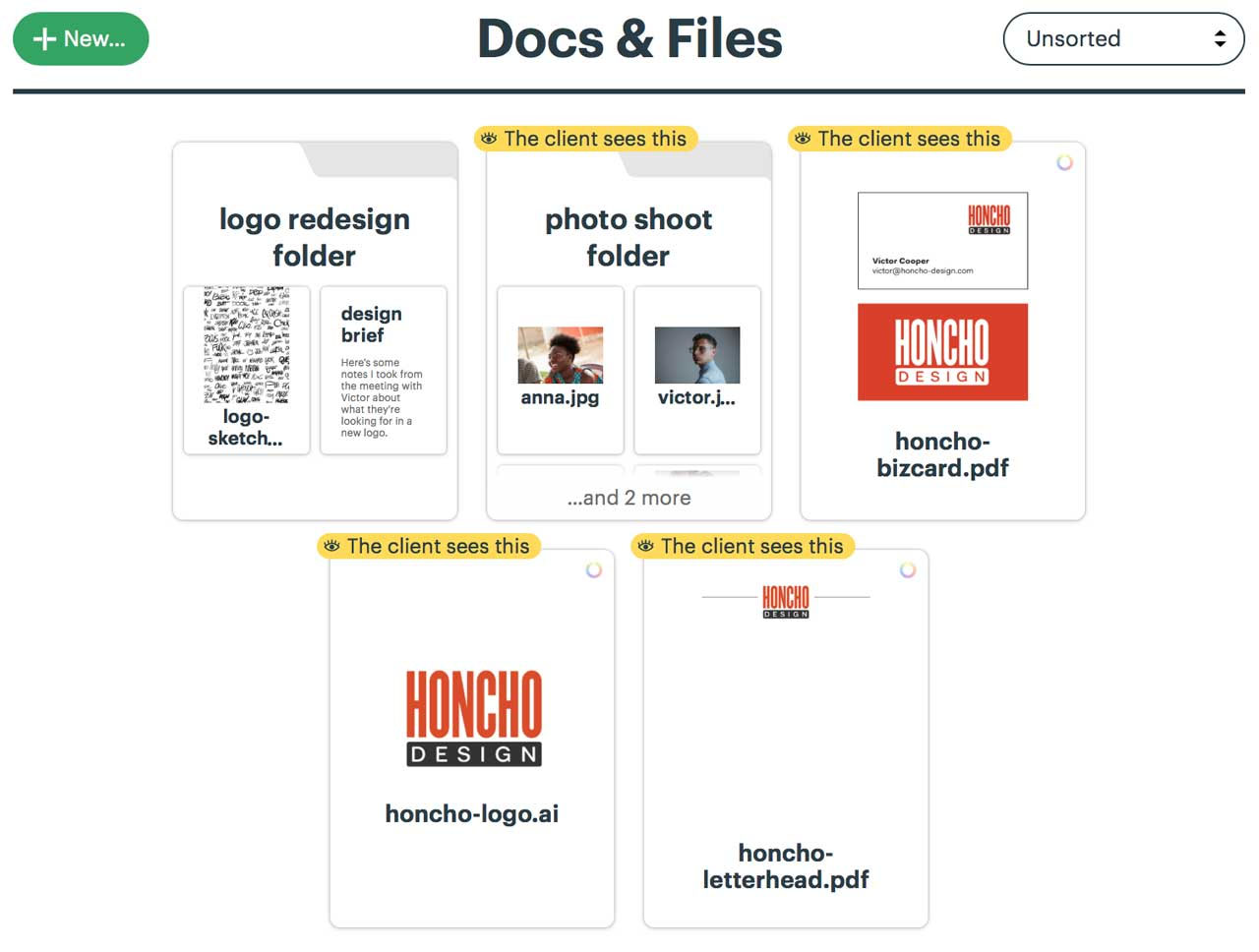
Find out which project files were accessed by your client. (Source: Basecamp)
- Lineup: It works like a timeline view that displays the start and end dates of a project. This gives you a quick overview of the amount of time remaining, relative to today.
- Latest activity: It displays a micro-view of the real-time updates across the team. A predefined screen displays any user’s current task lineup, which you can view any time you want.
- My Stuff: It provides a one-click menu that is accessible from any screen and shows all the current tasks you’ve been assigned.
How We Evaluated the Best Project Management Software for Individuals
We handpicked a variety of project management tools based on popularity, industry sentiments, and functionality ratings among users. From there, we designed a six-category rubric to accurately evaluate and compare all the providers we will cover. After computing the final scores, we selected eight providers based on which ranked the highest.
Learn how we evaluated the best project management apps for individuals by clicking on the tabs below:
20% of Overall Score
Affordability is a crucial factor when looking for project management software for personal use. It should offer various pricing options, including a free version and fairly priced paid plans. We explored the feature inclusions of each provider and gave more weight to those offering discounted annual billing and a lengthy free trial for the paid plans.
25% of Overall Score
The best project management software includes essential features that allow users to create, monitor, and assign tasks. We looked for basic capabilities like cloud storage, task management, and multiple project views. We also checked if the platform works across various devices, integrates with popular third-party apps, and offers extensive customization options.
20% of Overall Score
Project management providers offer niche capabilities to accommodate unique workflows and productivity needs. We looked for advanced features like time tracking, budgeting, and automation. We also considered the availability of resource management tools and the type of security measures in place.
10% of Overall Score
We assessed the usability of each software by testing it ourselves and analyzing customer reviews from reliable websites. We reviewed the feedback of recent users and checked for learning curves during the setup and configuration phase. The quality of onboarding resources was also considered.
10% of Overall Score
For each project management software, we checked the type of customer service channels offered, like phone, live chat, email, and helpdesk. We gave higher points for 24/7 coverage.
15% of Overall Score
We assessed the performance of each project management software by looking at its standout features and user-friendliness. We also considered their level of popularity and value for money.
Frequently Asked Questions (FAQs)
We recommend Trello for solopreneurs because besides its affordability (it starts at $6 per user monthly), it offers a straightforward solution without the fancy features. Its simple and visually appealing kanban-style boards make it ideal for individual users who are dealing with small-scale projects and are new to project management software.
Choosing the right features for your personal project management solution depends on your project type and requirements. However, in general, many individual users look for features that help them manage their workflow efficiently. These include task templates, checklists, time tracking, real-time notifications, and automation tools.
The answer depends on the type of projects you manage. A collaboration-ready project management software is applicable for users needing to present data to external stakeholders like customers, partners, and vendors. If external accessibility is involved, you’ll need a solution with user access management and collaboration capabilities.
Bottom Line
Whether you’re a solopreneur, a freelancer, or an individual employee struggling to juggle tasks, you need a reliable project management tool for managing your time and projects together. It should also fit your budget and provide enough flexibility to adapt to your unique workflow.
We chose ClickUp as our best project management software for individuals as it’s tailored to support remote working requirements. For as low as $10 per user monthly, you can add tasks even without an internet connection and access a host of features across multiple devices. Sign up for ClickUp’s free plan to fully explore its unique offerings.